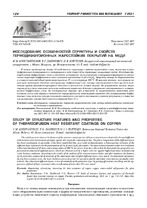Исследование особенностей структуры и свойств термодиффузионных жаростойких покрытий на меди

Date
2021Publisher
Another Title
Study of structure features and properties of thermodifusion heat resistant coatings on copper
Bibliographic entry
Константинов, В. М. Исследование особенностей структуры и свойств термодиффузионных жаростойких покрытий на меди = Study of structure features and properties of thermodifusion heat resistant coatings on copper / В. М. Константинов, В. Г. Дашкевич, И. В. Плетенев // Литье и металлургия. – 2021. – № 1. – С. 124-129.
Abstract
В статье представлены данные об особенностях структуры и свойств жаростойких слоев, полученных термодиффузионным алитированием и силицированием меди (марка М1) в порошковых насыщающих средах. Исследован фазовый состав диффузионных слоев, в частности, установлено, что в результате алитирования формируется гетерогенная структура диффузионного слоя с участием алюминидов Cu3Al и Cu9Al4. Приведены данные по жаростойкости в услових испытаний общей продолжительностью 25 ч и температуре 800 ºС. Испытания показали, что лучшими защитными свойствами обладают алитированные диффузионные слои, которые характеризуются более высокой стойкостью против высокотемпературного окисления и циклических условий нагрева. По результатам анализа микроструктур до и после окисления отмечены особености защитного действия и разрушения алитированного и силицированного диффузионных слоев. На алитированных образцах при испытаниях на жаростойкость происходит рост толщины слоя в глубь образца и постепенное перераспределение концентрации алюминия. Для силицированных диффузионных слоев отмечена потеря сплошности защитного слоя путем отслаивания участков (вспучивание) и появление очагов коррозии слоя при длительности испытаний более 15 ч.
Abstract in another language
The article presents data on the features of the structure and properties of heat-resistant layers obtained by thermal diffusion aluminization and siliconization of copper (grade M1) in powder saturating media. The phase composition of the diffusion layers has been investigated, in particular, it has been established that, as a result of aluminization, a heterogeneous structure of the diffusion layer is formed with the participation of Cu3Al and Cu9Al4 aluminides. The data on heat resistance under test conditions with a total duration of 25 hours and a temperature of 800 °C are given. Tests have shown that the best protective properties are possessed by aluminized diffusion layers, which are characterized by a higher sink rate against high-temperature oxidation and cyclic heating conditions. According to the results of the analysis of the microstructures before and after oxidation, the features of the protective action and destruction of the aluminized and silicified diffusion layers were noted. On aluminized specimens, during heat resistance tests, the layer thickness grows deep into the specimen and the aluminum concentration gradually redistributes. For siliconized diffusion layers, a loss of continuity of the protective layer by peeling off sections (swelling) and the appearance of focal of layer corrosion with a test duration of more than 15 h were noted.
View/
Collections
- № 1[22]
